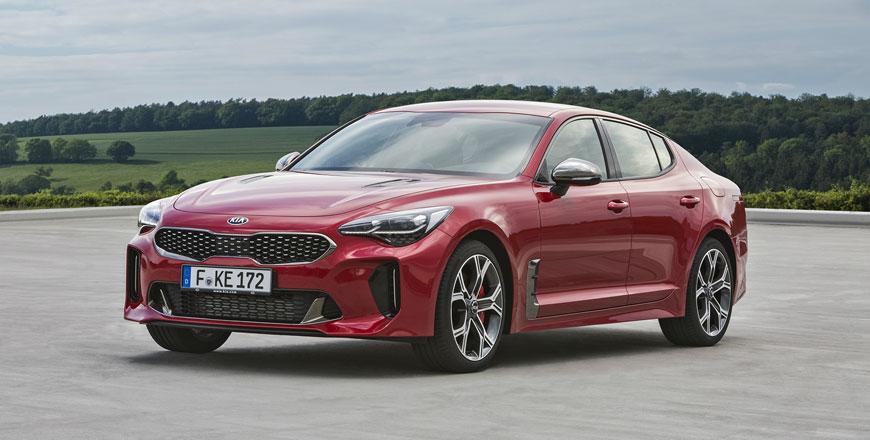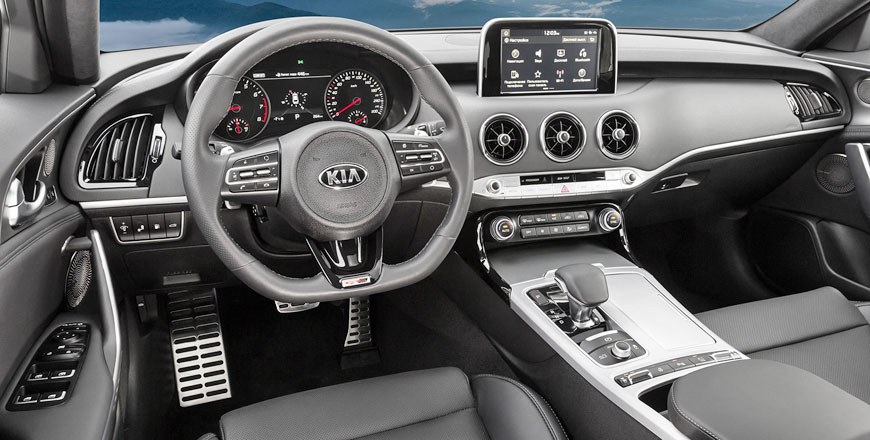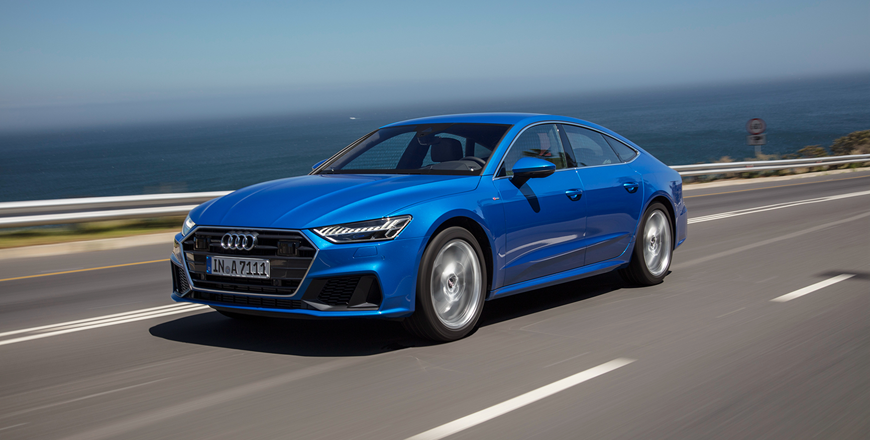You are here
Kia Stinger 3.3 AWD: Once stung, never forgotten
By Ghaith Madadha - Sep 17,2018 - Last updated at Sep 18,2018

Photos courtesy of Kia

With the right name, right look and right driving characteristics, the Kia Stinger is, without qualification, the Korean brand’s best car to date, and the one that is sure to make the biggest impact as an aspirational halo model.
Delivering on the promise of a sporting premium four-door grand tourer that was the 2011 Frankfurt Motor Show debuting GT Concept, the Stinger is the Kia that finally sets its sights on impressing drivers who are passionate about cars.
Launched as a 2018 model, the Stinger is ambitiously positioned to compete with coupe-like German saloons.
Slightly larger than the Audi A5 Sportback and more sporting in flavour than the Volkswagen CC, the Stinger is also a viable and affordable alternative to entry level and mid-range versions of the slightly larger Porsche Panamera, Mercedes-Benz CLS-Class, BMW 6-Series Gran Coupe and Audi A7. Developed with European designers and engineers headhunted from premium sports manufacturers, the Stinger largely holds its own among lofty competition. And crucially, the Stinger name is a welcome departure for Kia, with a visceral, evocative and descriptive tone more similar to the Dodge Charger and Challenger.
Slinky silhouette
True to the striking original Kia GT Concept, the production Stinger may have ditched the pillar-less glasshouse, bonnet mounted rearview cameras and other motor show concept elements for practicality and engineering necessity, but nevertheless remains clearly recognisable.
It retains the same long and slinky silhouette, with short front overhang, distance between the front wheel and A-pillar, indulgently long bonnet and low roofline. The Stinger even keeps similar front and rear fascias, albeit with less pronounced side gills and less complex front headlights, but features almost the same exact slim wraparound rear light outline.
Less minimalist in details and surfacing than the GT Concept, the Stinger sits with a more muscularly road-hugging emphasis on width. Eager and seemingly ready to pounce at standstill, its rearwards cabin contrasts with a pert rear that is reminiscent of the Maserati 3200GT.
Sporting details include wide honeycomb grille, low and sharp air splitter, bonnet and side extraction vents, muscular sills, strong shoulders, quad tailpipes and sticky low profile 225/40R19 front and 255/35R19 rear tyres. With a rakishly low roofline, the Stinger’s generous rear hatchback — rather than a narrow and compromised boot — provides excellent cargo access.
Mid-range muscle
Positioned far back under its lasciviously long bonnet for near ideal weight distribution and driving all four wheels with a balanced rear-drive derived four-wheel-drive system, the range-topping Stinger — as driven — is powered by a 3.3-litre twin-turbocharged direct injection V6 engine.
Producing 365BHP at 6,000rpm and 376lb/ft torque throughout a broad and accessible 1,300-4,500 band, the Stinger also delivers excellent off the line four-wheel-drive traction, which allows it to rocket through the 0-100km/h acceleration benchmark in 4.9-seconds and onto a 270km/h top speed.
With power accumulation underwritten by an effortlessly accessible and versatile torque band, the Stinger is also quick through 80-120km/h at 3.3-seconds.
Smooth in delivery, the Stinger’s engine is nevertheless responsive from low-end, with quick spooling turbos soon delivering a torrent of torque and urgent power build-up. Progressive in power delivery, the Stinger does its best work in its broad, muscular and versatile mid-range, where it pulls viciously hard. Shifting just as the rev needle hits the redline using its manual mode paddle shifters for best results, the Stinger’s 8-speed gearbox is otherwise smooth and quick shifting in auto modes, and is able to take successive commands, but can be a bit conservative when asked to downshift into very high revs. Meanwhile, large Brembo brakes proved tirelessly effective.
Adjustable abilities
Almost docile in character when driving with a light foot and in its Eco and Comfort driving modes, the Stinger adopts a more focused profile in Sport mode. More so, allows one to individually tailor engine and transmission, steering, suspension, four-wheel-drive and engine sound setting through the dash-mounted infotainment touch screen, with the latter setting yielding a more vocal churning roar and growl.
Meanwhile, the Stinger’s quoted combined 10.6l/100km fuel efficiency is moderate for a car of this performance level and 1,834kg weight, but rises somewhat when one begins to explore its generous mid-range grunt and top-end performance potential.
A car that certainly “stings like a bee” in terms of performance, Kia’s four-door grand tourer may also have unexpected ride comfort levels, but it is far too focused, settled and taut through corners to “float like a butterfly”, as Muhammad Ali might have put it. Eager into corners, the Stinger does a terrific job of keeping understeer at bay, but at the same time also grips much harder at the rear than many modern sports saloons. Balanced through corners and with good body control, the Stinger delivers an intuitive feel for its rear grip limit and any potential drift.
Grip and agility
Easy to control through corners, the Stinger’s steering is precise, very quick and gives unexpected feel when loaded up. Rear drifts are easy to control, with electronic stability control and torque vectoring working to briefly cut power and apply brakes to tighten a cornering line. Meanwhile, one can alternately turn in tight and early to point the Stinger in the right direction before coming back on the throttle so that power is reallocated to the front to pull it out of a corner, while the rear squats down and digs deep for more traction. Additionally, the Stinger can be specified with a limited slip rear differential for better handling and agility.
Smooth, refined and planted at speed, the Stinger’s suspension is taut, but with enough suppleness to take the edge off of its firm low profile tyres. Adaptive suspension allows for more comfort or body control, while vertical control is settled. A slightly sportier and more up-market take on Kia interior design, the Stinger’s cabin used good materials and build and is ergonomic and user-friendly, if not particularly emotive. Front space is good with a supportive and sporty driving position and a 360 degrees parking monitor for easier manoeuvrability. At the rear it features wide door swing angles and good legroom, but the rakish roofline reduces headroom for tall rear passengers.
TECHNICAL SPECIFICATIONS
- Engine: 3.3-litre, twin-turbo, in-line V6-cylinders
- Bore x stroke: 92 x 83.8mm
- Compression ratio: 10:1
- Valve-train: 24-valve, DOHC, direct injection
- Gearbox: 8-speed automatic, four-wheel-drive
- Ratios: 1st 3.665; 2nd 2.396; 3rd 1.61; 4th 1.19; 5th 1.0; 6th 0.826; 7th 0.643; 8th 0.556
- Reverse/final drive: 2.273/3.538
- Power, BHP (PS) [kW]: 365 (370) [272] @6,000rpm
- Specific power: 109.2BHP/litre
- Power-to-weight: 199BHP/tonne
- Torque, lb/ft (Nm): 376 (510) @1,300-4,500rpm
- Specific torque: 152.6Nm/litre
- Torque-to-weight: 278Nm/tonne
- 0-100km/h: 4.9-seconds
- 80-120km/h: 3.3-seconds
- Top speed: 270km/h
- Fuel consumption, urban/extra-urban/combined:
- 14.2/8.5/10.6-litres/100km
- CO2 emissions, combined: 244g/km
- Fuel capacity: 60-litres
- Length: 4,830mm
- Width: 1,870mm
- Height: 1,400mm
- Wheelbase: 2,905mm
- Overhangs, F/R: 830/1,095mm
- Legroom, F/R: 1,083/925mm
- Luggage volume, min/max: 406-/1,114-litres
- Kerb weight: 1,834kg
- Steering: Electric-assisted, variable ratio rack & pinion
- Lock-to-lock: 2.1-turns
- Turning Circle: 11.7-metres
- Suspension: MacPherson struts/double wishbones, adaptive dampers
- Brakes, F/R: Ventilated discs, 350mm/340mm
- Tyres, F/R: 225/40R19/255/35R19
- Price, on the road, no insurance: JD59,000 (as tested)
Related Articles
Swimming alongside predominantly German cars in the mid-size executive segment, the shark-like Maserati Ghibli competes with traditional sal
First launched in 2010 as the Ingolstadt manufacturer’s dramatic, sure-footed and user-friendly alternative to the fashionable Mercedes-Benz
Among the most popular player in the popular compact pick-up segment which accounts for some 90 per cent of truck sales in the Middle East,



















